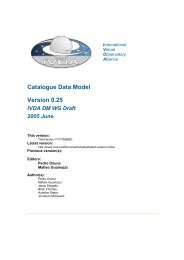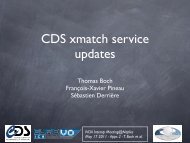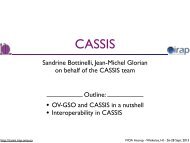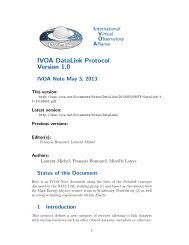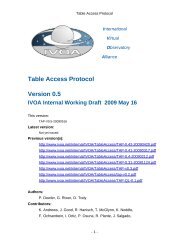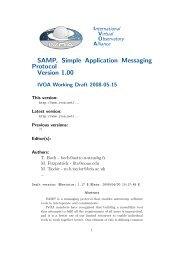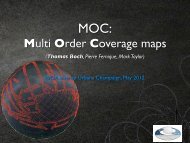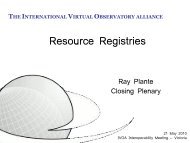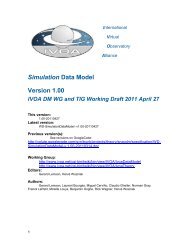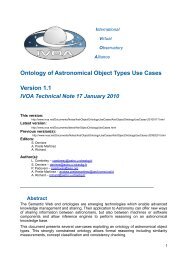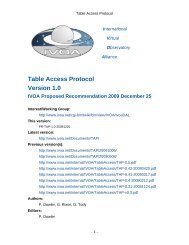SAMP â Simple Application Messag- ing Protocol Version 1.11 - IVOA
SAMP â Simple Application Messag- ing Protocol Version 1.11 - IVOA
SAMP â Simple Application Messag- ing Protocol Version 1.11 - IVOA
You also want an ePaper? Increase the reach of your titles
YUMPU automatically turns print PDFs into web optimized ePapers that Google loves.
3. Await client registrations. When a client makes a legal registration,assign it a public ID, and add the application to the table of registeredclients under the public ID. Broadcast a message announc<strong>ing</strong> theregistration of a new client.4. When a client stores metadata in the hub, broadcast a message announc<strong>ing</strong>the change and make the metadata available.5. When a client updates its list of subscribed MTypes, broadcast a messageannounc<strong>ing</strong> the change and make the subscription informationavailable6. When the hub receives a message for relay<strong>ing</strong>, pass it on to appropriaterecipients which are subscribed to the message’s MType. Broadcastmessages are sent to all subscribed clients except the sender, messageswith a specified recipient are sent to that recipient if it is subscribed.7. Await client unregistrations. When a client unregisters, broadcast amessage announc<strong>ing</strong> the unregistration and remove the client from thetable of registered clients.8. If the hub is unable to communicate with a client, it may unregister itas described in phase 7.9. When the hub is about to shutdown, broadcast a message to all subscribedclients.10. Delete the hub discovery record.Phases 3–8 are responses to events which may occur multiple times and inany order.The MTypes broadcast by the hub to inform clients of changes in its stateare given in Section 5.4.1.Readers should note that, given this scheme, race conditions may occur.A client might for instance try to register with a hub which has just shutdown, or attempt to send to a recipient which has already unregistered. Specificprofiles MAY define best-practice rules in order to best manage theseconditions, but in general clients should be aware that <strong>SAMP</strong>’s lack of guaranteedmessage delivery and tim<strong>ing</strong> means that unexpected conditions arepossible.2.5 <strong>Messag</strong>e Delivery Patterns<strong>Messag</strong>es can be sent accord<strong>ing</strong> to three patterns, differ<strong>ing</strong> in whether andhow a response is returned to the sender:1. Notification2. Asynchronous Call/Response9



